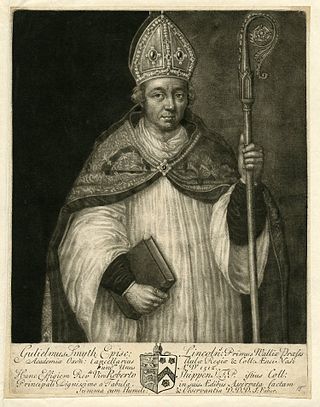
Hertford College, previously known as Magdalen Hall, is a constituent college of the University of Oxford in England. It is located on Catte Street in the centre of Oxford, directly opposite the main gate to the Bodleian Library. The college is known for its iconic bridge, the Bridge of Sighs. There are around 600 students at the college at any one time, comprising undergraduates, graduates and visiting students from overseas.

Frederic Edward Weatherly, KC was an English lawyer, author, lyricist and broadcaster. He was christened and brought up using the name Frederick Edward Weatherly, and appears to have adopted the spelling 'Frederic' later in life. He is estimated to have written the lyrics to at least 3,000 popular songs, among the best-known of which are the sentimental ballad "Danny Boy" set to the tune "Londonderry Air", the religious "The Holy City", and the wartime song "Roses of Picardy".

William Smyth was Bishop of Coventry and Lichfield from 1493 to 1496 and then Bishop of Lincoln until his death. He held political offices, the most important being Lord President of the Council of Wales and the Marches. He became very wealthy and was a benefactor of a number of institutions. He was a co-founder of Brasenose College, Oxford and endowed a grammar school in the village of his birth in Lancashire.
George Carnac Fisher was Bishop of Southampton from 1896 to 1898 and Bishop of Ipswich from 1899 to 1906.
William Teulon Swan Stallybrass was a barrister, Principal of Brasenose College, Oxford, from 1936, and Vice-Chancellor of the University of Oxford from October 1947 until his death.

Charles Buller Heberden was an English classical scholar and academic administrator. He was principal of Brasenose College, Oxford (1889–1920) and served as vice-chancellor of Oxford University.

Arthur Chandler (1859–1939) was Bishop of Bloemfontein from 1902 until 1920.

Henry Herbert Williams was an English clergyman who served as Bishop of Carlisle.

William Cleaver (1742–1815) was an English churchman and academic, Principal of Brasenose College, Oxford, and bishop of three sees.
Charles Edward Plumb (1864–1930) was an Anglican priest in the first third of the 20th century.
Robert Shippen D.D. FRS (1675–1745) was an English academic administrator at the University of Oxford.
Daniel Greenwood was an English clergyman and academic administrator at the University of Oxford.
The history of Brasenose College, Oxford, stretches back to 1509, when Brasenose College was founded on the site of Brasenose Hall. Its name is believed to derive from the name of a bronze knocker that adorned the hall's door. The college was associated with Lancashire and Cheshire, the county origins of its two founders – Sir Richard Sutton and the Bishop of Lincoln, William Smyth – a link that was maintained strongly until the latter half of the nineteenth century. The first principals navigated Brasenose, with its Catholic sympathisers, through the reformation and continuing religious reforms. Most of Brasenose favoured the Royalist side during the English Civil War, although it produced notable generals and clergy on both sides. The library and chapel were completed in the mid-seventeenth century, despite Brasenose suffering continuing financial problems.
Charles Leslie Dundas was an eminent Anglican priest in the late nineteenth and early twentieth centuries.
Charles Henry Dickinson (1871–1930) was Archdeacon of Bristol from 1921 until 1927.
Richard Newman was the Archdeacon of Blackburn from 1936 to 1946.
Maurice Platnauer was Principal of Brasenose College, Oxford, from 1956 to 1960.

Samuel Radcliffe was an Oxford academic and clergyman.
The Rev. Albert Watson was an Oxford college head in the 19th century.
Neville Richard Murphy was Principal of Hertford College, Oxford from 1939 to 1959.
This page is based on this
Wikipedia article Text is available under the
CC BY-SA 4.0 license; additional terms may apply.
Images, videos and audio are available under their respective licenses.








